About Indian Musical Instruments
 Indian musical instrument is as old as its musical tradition and culture. This fascination is passionately encased into the poetic and mythic imagination of the Indians and is reverberated amidst the fervour of folktales, fables, myths and legends. Indian musical instruments thus have a rich timeline. In fact when Lord Shiva as the epitome of the creator, destroyer and sustainers danced the Tandava then each pounding beat of his Damaru (the small drum Lord Shiva holds in His hand) alternated the forces of darkness and light. The terrible yet awe-inspiring, passionate yet fierce sound of the Damaru is said to be the origin of the concept of the musical instrument. Mythology asserts that Lord Shiva, the lord of dance, gifted humanity four instruments; the Veena, the Venu, the Damaru and the Mridanga. This indeed connotes that these might have been the primordial parent instruments. That was just the beginning of the journey of musical instruments in India as a devotional offering and accompaniment of music.
Indian musical instrument is as old as its musical tradition and culture. This fascination is passionately encased into the poetic and mythic imagination of the Indians and is reverberated amidst the fervour of folktales, fables, myths and legends. Indian musical instruments thus have a rich timeline. In fact when Lord Shiva as the epitome of the creator, destroyer and sustainers danced the Tandava then each pounding beat of his Damaru (the small drum Lord Shiva holds in His hand) alternated the forces of darkness and light. The terrible yet awe-inspiring, passionate yet fierce sound of the Damaru is said to be the origin of the concept of the musical instrument. Mythology asserts that Lord Shiva, the lord of dance, gifted humanity four instruments; the Veena, the Venu, the Damaru and the Mridanga. This indeed connotes that these might have been the primordial parent instruments. That was just the beginning of the journey of musical instruments in India as a devotional offering and accompaniment of music.
Realistically a number of ancient Indian mural paintings, sculptures, literal and ancient theoretical works hold reference of the presence of the four primordial instruments like the Veena, Venu Mridanga and Damaru. With the passage of time, these Indian musical instruments underwent a thousand transformation and mutations and diversified into numerous other instruments. Regional as well as the geographical factors indeed contributed to the diversity of the tonal quality and in the variations in the designs of the Indian musical instruments. Many of the musical instruments seen today evolved in the medieval India owing to contacts with the Persian and Middle Eastern cultures. A number of musical instruments germinated as a result of the cultural fusion with the Islamic invasion in India. Rubab is one such musical instrument which came to India from Persia via Afghanistan during the time of early Islamic invasion and was indeed a part of the musical ensemble of the Mughal era.
With the advent of the colonial era, Indian musical instruments underwent a sea change. Instruments like the violin, the guitar, the mandolin, the clarinet and the saxophone were imported from the West and were largely absorbed in the philosophy of Indian music.
 Whatever be the origin, however deep may be the influence of society, culture, more and tradition in delineating the tone, form and designs of Indian musical instruments, in broader aspect Indian musical instruments can be classified into four main heads depending upon the sound they produce. Bharata muni in his Natyashastra also classified Indian musical instruments into four broad categories namely, the stringed instruments (tat or Tantra Vadya), the wind instruments (Sushira Vadya), the Ghana Vadya and the percussion instruments (Avanaddha Vadya). This mode of classification even survives today despite the introduction of newer musical instruments into the field.
Whatever be the origin, however deep may be the influence of society, culture, more and tradition in delineating the tone, form and designs of Indian musical instruments, in broader aspect Indian musical instruments can be classified into four main heads depending upon the sound they produce. Bharata muni in his Natyashastra also classified Indian musical instruments into four broad categories namely, the stringed instruments (tat or Tantra Vadya), the wind instruments (Sushira Vadya), the Ghana Vadya and the percussion instruments (Avanaddha Vadya). This mode of classification even survives today despite the introduction of newer musical instruments into the field.
The string instruments are those which produce sounds when the strings are plucked with a finger or strapped, slapped or strummed. Indian musical instruments like the Rudra Veena, sitar, sarod and even Surbahar fall in this category. There is another category of stringed instrument like the violin, esraj, dilruba and the tar Shehnai, which make use of a bow to produce an uninterrupted series of notes.
Wind instruments on the other hand produce music when an unbroken stream of air is blown through them. The wind instruments like the flute, shehnai and the clarinet generate a sound when a column of air is made to vibrate inside them. The frequency of the wave generated is related to the length of the column of air and the shape of the instrument, while the tone quality of the sound generated is affected by the construction of the instrument and method of tone production.
The Ghana Vadya is the Indian musical instruments which produce music when the strings are struck with strikers made of wood or metal. Instruments like santoor, jaltarang falls in this category. The percussion instruments amongst wide variety of the Indian musical instruments are the ones which create sound with or without pitch when drummed. The North Indian Pakhvaj, the South Indian Mridanga, Dholak and tabla are the percussion instruments which are made of animal membranes and produce sound if and when drummed.
Indian musical instruments since ages with their timbre, style and form has silhouetted the Indian music to a great extent. The legacy of Indian musical instrument which started by the divinities and sub divinities by the musical orchestra in manning the "terrible sublime sound" of the Damaru of Lord Shiva is no more just a mythological concept but a concrete realism in shaping the musical tradition in India.
Classification of Indian musical instruments
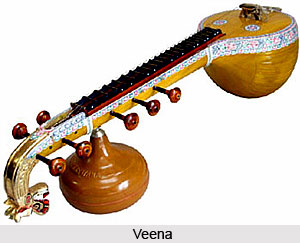 Classification of Indian Musical Instruments can actually be traced back to rather ancient times. The classification of instruments as laid down by Bharata is in fact the most accepted one in Indian Music today. There are a number of different criteria based on which instruments may be classified, such as material of construction, method of playing, functional use and so on. Keeping all these in mind, it seems the most logical classification of instruments was made by Bharata.
Classification of Indian Musical Instruments can actually be traced back to rather ancient times. The classification of instruments as laid down by Bharata is in fact the most accepted one in Indian Music today. There are a number of different criteria based on which instruments may be classified, such as material of construction, method of playing, functional use and so on. Keeping all these in mind, it seems the most logical classification of instruments was made by Bharata.
History of Classification of Indian Musical Instruments
In Bharata`s Natyashastra, he gives a four-fold classification of instruments. These are Tata-those which have strings, Avanaddha-drums, Ghana-cymbals, Sushira-flute. There are some who recognise only three categories- Tata, Vitata and Tata-Vitata, though the meaning of the last is not too clear. Even Narada, in the 1st century AD had given three divisions- Charma (leather), Tanirika (stringed) and Ghana (solid). According to Kohala (prior to sixth century AD) there are four classes: Sushira, Ghana, Charmabaddha (covered with membrane) and Tantri. Haripala (twelfth century, AD) in Sangeeta Sudhakara mentions four types of instruments: Sushira-flute, etc., Tata-Veena etc., Vitata-Mridanga etc., Ghana-cymbals etc.
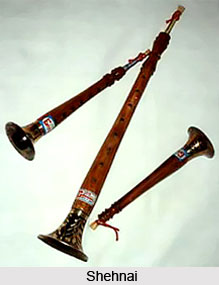 The Tamil language word for instrument, the oldest in Dravidian terminology, as found in the Sangam literature of Tamil Nadu from the second to sixth centuries AD is Karuvi which literally means a tool and in a musical context an instrument. Five kinds of these were recognized: Tor-Karuvi, Tulaikkaruvi, Narampukkaruvi, Miatrukkaruvi, Kanchakkaruvi. The first class comprised drums (tole=hide); tulaikkaruvi is one with holes or a hollow, and hence a wind instrument (tulai=hole); narampu means animal gut and therefore stringed instruments fall into the third category; mitatrukkaruvi is the human voice; Kanchakkaruvi is one made of metal, cymbals, for instance. This system is parallel in details to the old Sanskrit grouping: Avanaddha, Sushira, Tata, Gatra (voice) and Ghana. Functionally, three groups were recognized: Geetanuga- suitable for accompanying singing, Nrityanuga- suitable for accompanying dancing, and Suska-solo instruments.
The Tamil language word for instrument, the oldest in Dravidian terminology, as found in the Sangam literature of Tamil Nadu from the second to sixth centuries AD is Karuvi which literally means a tool and in a musical context an instrument. Five kinds of these were recognized: Tor-Karuvi, Tulaikkaruvi, Narampukkaruvi, Miatrukkaruvi, Kanchakkaruvi. The first class comprised drums (tole=hide); tulaikkaruvi is one with holes or a hollow, and hence a wind instrument (tulai=hole); narampu means animal gut and therefore stringed instruments fall into the third category; mitatrukkaruvi is the human voice; Kanchakkaruvi is one made of metal, cymbals, for instance. This system is parallel in details to the old Sanskrit grouping: Avanaddha, Sushira, Tata, Gatra (voice) and Ghana. Functionally, three groups were recognized: Geetanuga- suitable for accompanying singing, Nrityanuga- suitable for accompanying dancing, and Suska-solo instruments.
Classification of Indian Musical Instruments by Bharata
By far the most popularly followed classification of Indian instruments is the one laid down by Bharata. As has already been mentioned, he classified instruments into four categories. These are- string instruments called Tata, drums called Avanaddha, Cymbals called Ghana and wind instruments known as Sushira. Tata is derived from the root ton-to stretch of tense. That is, these instruments have some form of gut, wire, etc., stretched to produce sound. Avanaddha means, to be covered. So, all instruments that have one or two faces covered with hide, drums in general, are Avanaddha. Ghana indicates solid instruments. These do not require any further tuning once they are made; to this class belong cymbals, castanets, rattles and so on. Sushira literally means hollow. All instruments where wind is the producer of sound or the cause of excitement of any other mechanism- flute, Nagasvaram, Shehnai etc.-come under this section. While the classes as given by Bharata have remained the same through the centuries, some appellations have changed. For instance, Anaddha is substituted for Avanaddha. Similarly the word Vitata (without strings) is also used instead of Avanaddha.
This ancient division has not been bettered and in fact it will not be wrong to say that the classification of musical instruments in western musicology is along the same lines.
Musical Instruments of Ancient India
Music has been an integral part of the culture of India since ancient times. A number of styles and traditions of music have evolved in the country over years and Musical Instruments of Ancient India served greatly to make the Indian music more enchanting. Several ancient instruments had originated amidst the folk culture whereas many of them had been patronized by the emperors of India. These instruments have however undergone numerous transformations in course of time to enhance its performance.
 Bansuri
Bansuri
Bansuri, also known as flute, is an ancient musical instrument of India. It is a woodwind instrument without any reed. The melodious sound is produced with the flow of air across the small openings on the flute. Flute is made of a single hollow shaft of bamboo. Traditionally this musical instrument is linked with cowherds, especially as the divine instrument of Lord Krishna. Several Buddhist paintings of ancient times have also depicted this instrument. A flute covers three octaves and comes in various sizes and designs.
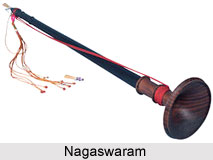 Nagaswaram
Nagaswaram
Another musical instrument of ancient India is Nagaswaram. Commonly used in Indian classical music, Nagaswaram is prevalent in south Indian culture. The instrument is famous for its auspiciousness and is thus played in temples and wedding since ancient past. Nagaswaram is generally played in pairs and is played along with thavils, a kind of drum. It covers two and a half octaves and has seven finger holes to control the melodies produced by it. The sound of the instrument is quite intense and loud and therefore is usually played in outdoor concerts.
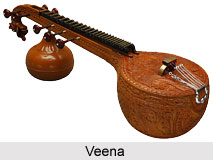 Veena
Veena
The renowned musical instruments of Indian classical music also include Veena. It is a plucked stringed instrument which has undergone several transformations over time. The instrument finds its mention in Rig Vedas. Ancient Veena had a close resemblance arched harp until Gupta period. A depiction of the playing of Veena in ancient time can be found in the gold coins of Samudragupta. The body of the instrument is made of teak wood whereas its bridges are made of ebony, camel bone or deer horn. Often synthetic material is also used.
Gottuvadhyam
The origin of Gottuvadhyam can be traced back to many centuries. It has been mentioned as seven string fretless instrument in Bharata`s Natya Shastra. The instrument is prominent in Carnatic Music and has gone through various phases of development. It is an important part of North-south Indian jugalbandis. The melody is produced by the instrument with the aid of six main strings whereas twelve sympathetic strings are also present below the main strings, running parallel.
Thavil
Several musical instruments originated in south India in ancient past among which Thavil is an important one. Primarily used by the temple folk to accompany Carnatic music along with Nagaswaram. It finds a significant place in ceremonies and traditional festivals. The instrument is made by cylindrical jackfruit wood which is covered by a stretch of animal skin on two sides.
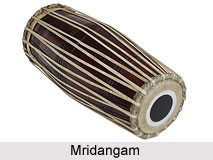 Mridangam
Mridangam
Mridangam is another instrument having ancient origin. This percussion instrument accompanies Carnatic music with beautiful rhythms. Mrindangam has been depicted as the instrument of several deities in ancient paintings and sculptures. Mythology says that, during Lord Shiva`s tandava dance, his vehicle Nandi played this instrument to produce a divine rhythm that resonated across the heavens. Mrindangam has evolved greatly in the course of time in terms of design. Different types of wood had been used in its manufacture to improve its rhythm and durability.
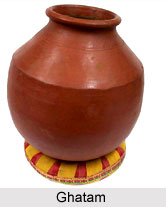 Ghatam
Ghatam
Ghatam is also an ancient musical instrument used extensively in Carnatic music. It is in fact enlisted among the oldest percussion instrument of south India. It is basically a clay pot having a narrow mouth. The size of Ghatam changes with the pitch. Manamadurai is a place near Madurai of Tamil Nadu which is considered as the centre of Ghatam manufacture.
Beautiful melodies and rhythms are produced by the Musical Instruments of Ancient India. Although numerous modern instruments have developed over time, the instruments of ancient times still hold a significant place in the world of Indian music. These musical instruments are the testaments of the glorious history of India and greatly enrich the cultural heritage of the country.
Musical Instruments of Medieval India
The sketch of Indian Culture remains incomplete without music. Since ancient times, the world of music has expanded with the emergence of new forms and styles of music. Instruments accompanying the music have also played a critical role in augmenting its essence. Musical Instruments of Medieval India had become quite popular and have brought about new dimensions in the Indian music. They have enriched the cultural heritage of India.
Rubab
Rabab is a famous musical instrument of medieval India that resembles a lute. It originated through Persian influence. Rabab is made up of a single piece of wood and animal skin is used to form the head and strings of the instruments. At one end of the instrument, a spike is present for balancing. Rabab can be played with the aid of a bow or by plucking with hands and has three main melody strings. However, with time and development of musical instruments, Rabab was gradually replaced by violin as Rabab had a limited range.
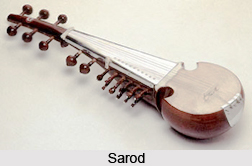 Sarod
Sarod
Sarod belongs to the same musical family as Rabab. An intense and deep sound is produced by Sarod and continuous slides between the musical notes can be created with it. A small tool, made of bones, is used to produce melodies by plucking the strings. The instrument gained much popularity in northern India.
Tambura
Tambura is another musical instrument belonging to medieval era. It is plucked lute instrument having a long neck. The instrument has four to five strings which creates different pitches when combined with Tambura of different sizes. It is made with a hollowed wood or a gourd. Jackwood is most commonly used for making Tamburas.
 Sitar
Sitar
Sitar is a plucked musical instrument which originated in the medieval period. Sympathetic strings on Sitar are used to produce resonance. It is made of a gourd chamber and a long hollow neck which is composed of wood. Precise tuning is required in Sitar to produce beautiful melodies.
Dilruba
Dilruba is a famous musical instrument of medieval India which was prevalent mainly in north-west India. It has a long neck having 18 strings. The instrument is tuned in a similar fashion to sitar. However Dilruba is played only with one main string. A number of sympathetic strings are also present in it.
Pakhavaj
Pakhavaj is percussion instrument and a descendent of ancient instrument Mridangam. It is a two headed drum having a barrel shape. It is used extensively to accompany dance and music performances. The rhythms are played in this instrument with series mnemonic syllables.
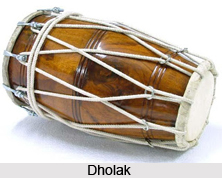 Dholak
Dholak
Dholak is basically a folk instrument of medieval India. It is a two headed drum and the pitch depends on the size of the instrument. Dholak is extensively used along with kirtan, bhangra and qawwali.
Other Musical Instruments of Medieval India
In addition to these, other Musical Instruments of Medieval India are Veena, Sarangi, Mayuri, Tabla, Nakkara, Bansuri, Been etc.
Musical Instruments of Medieval India have undergone great transformations through years. These instruments have added vigour to the traditions and culture of India and have been a significant part of the lives of Indians.
Musical Instruments of Modern India
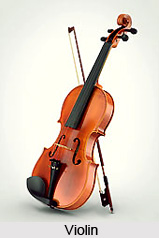 Musical Instruments of Modern India have developed over years to accompany different genres of music. Music is one of the finest forms of expressions and forms an inseparable part of the Indian culture. Musical instruments play a crucial role in enhancing the essence of music. Be it classical, folk or contemporary music, a number of musical instruments have developed which make any kind of music more enchanting.
Musical Instruments of Modern India have developed over years to accompany different genres of music. Music is one of the finest forms of expressions and forms an inseparable part of the Indian culture. Musical instruments play a crucial role in enhancing the essence of music. Be it classical, folk or contemporary music, a number of musical instruments have developed which make any kind of music more enchanting.
Electric Guitar
Electric guitar is a popular string instrument. It has steel cored strings which can be made louder with the aid of amplifiers and speakers. Mostly these guitars have six strings but sometimes guitars having more than six strings are also manufactured. They accompany a variety of music genres like rock, pop, jazz etc.
Acoustic Guitar
Acoustic guitar employs acoustic methods to project the melodies or sounds produced by it. Electronic amplification is required to make the sounds of acoustic guitar audible.
Violin
It is another string instrument played with the aid of a bow. Violin produces enchanting melodies that accompany a variety of music genres.
Harp
Another famous musical instrument of modern India is harp. The components of harp include strings and resonator. Harps come in a variety of sizes and its strings are made of a variety of materials like nylon, gut, wire or silk. Harps accompany both folk as well as Indian classical music.
Piano
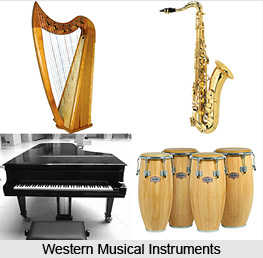 Piano is one of the most melodious musical instruments, which is played with the help of a keyboard. It is widely used along with Western music in solo as well as group performances. It is also useful in composing music and rehearsing them. Piano is a versatile instrument that is played along with a variety of music. Often it is categorized in both stringed and percussion instrument.
Piano is one of the most melodious musical instruments, which is played with the help of a keyboard. It is widely used along with Western music in solo as well as group performances. It is also useful in composing music and rehearsing them. Piano is a versatile instrument that is played along with a variety of music. Often it is categorized in both stringed and percussion instrument.
Drum
Drum is a percussion instrument. It is enlisted among the most ancient instruments of the world and the fundamental design of the drums has remained unchanged since ages. Drums are tuned according to various pitches and often, a group of drums are played together.
Conga
Conga is another percussion instrument. It is similar to a drum having a tall, narrow and single headed structure. Originally Congas were made with salvaged barrels but now a variety of materials are employed to manufacture them. Conga accompanies different forms of music providing great rhythms.
Bongo
Bongo comprises of two small drums and is categorized as percussion instruments. Two drums are of different sizes out of which the smaller one is called macho and the bigger one is called hembra.
Saxophone
Saxophone is a musical instrument belonging to woodwind family. It is played with the help of a single reed mouth piece resembling a clarinet and is usually made up of brass.
Trumpet
Trumpet is also an ancient musical instrument that is still prevalent in the modern India. The origin of trumpet dates back to 1500 BC. It is made of brass and is used for accompaniment in different forms of music such as classical, jazz etc.
Other Musical Instruments of Modern India
In addition to these, other Musical Instruments of Modern India includes Keyboards, Djembe, Clarinet, French horn, Silver flute, Pan Flute, Darbuka etc.
Musical Instruments of Modern India attained their present forms after undergoing through various transformations. Many ancient instruments have been changed and modernized to augment their effect, sounds and melodies. These instruments are an integral part of the cultural heritage of India.
Musical Instruments used during wars in South India
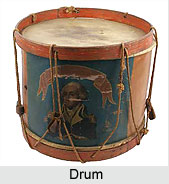 Usually, there is no direct relation between the wars and the musical instruments. The imagination of war during ancient and medieval India brings into mind the soldiers marching on foot, on horseback or elephant-back clutching various kinds of weapons. The war is also related with much killing, bloodshed, capture and torture.
Usually, there is no direct relation between the wars and the musical instruments. The imagination of war during ancient and medieval India brings into mind the soldiers marching on foot, on horseback or elephant-back clutching various kinds of weapons. The war is also related with much killing, bloodshed, capture and torture.
But, the musical instruments were used earlier in South India during the march and also during the actual battle. The loud sound of the music was used to entertain the soldiers, to motivate and to cheer the soldiers to give their best on the battlefield. In ancient time, the musical instruments were must during the wars in South India. The reference of it can be found in the Rig Veda. The use of musical instruments during wars is mentioned in the great epics Ramayana and the Mahabharata also. But there was a distinct difference between the music which was played in the actual battlefield and that was played in the camps.
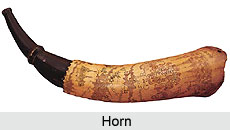 This tradition of martial music was quite well known by the ancient South Indian people. The references of the war musical instruments can be found in the ancient Tamil literature, especially of the Sangam age, such as the Purananuru. At that time, the conches, drums, trumpets, cymbals, horns, etc. were all used to create loud music. Some of the musical instruments used during war include the kodumparai, murasu, pandil, niduvayir, patuparai, karadikai and tudi.
This tradition of martial music was quite well known by the ancient South Indian people. The references of the war musical instruments can be found in the ancient Tamil literature, especially of the Sangam age, such as the Purananuru. At that time, the conches, drums, trumpets, cymbals, horns, etc. were all used to create loud music. Some of the musical instruments used during war include the kodumparai, murasu, pandil, niduvayir, patuparai, karadikai and tudi.
One type of Murasu, a type of drum named `Vira-murasu` was played during victorious moments in South India. The conch instrument was played during warfare. It was played during the Mahabharata war by Krishna and it was known as the famous conch Panchajanya of Krishna. In the ancient Tamil country, the musical instruments like the valvalai and varivalai were used during the war.
Musical Instruments of Northern India
Musical Instruments of Northern India have contributed greatly in enhancing the essence of different forms of Indian music. Music has been an inseparable part of Indian culture since time immemorial and numerous musical instruments have evolved over time to accompany them. People have crafted a number of instruments to accompany diverse forms of Indian music. Many of these instruments are exclusively played with specific genre of songs. Musical Instruments of Northern India have also undergone various changes and modifications to augment their rhythm, melody and durability. Early musical instruments were mainly manufactured with bones, animal skins and wood while present forms of instruments, in addition to these, have adopted various synthetic durable materials.
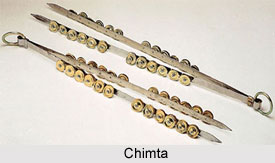 Musical Instruments of Punjab
Musical Instruments of Punjab
A number of musical instruments have evolved in Punjab which accompanies the Indian music beautifully. Algoze is a woodwind instrument resembling a couple of wooden flutes. It is played with the help of fingers and breathing into it. It is popular along with the folk songs of the state. Bugchu is another traditional instrument of the state used along with folk music and dances of Punjab. Its shape is similar to an hourglass with stretched skin covering its head. Chimta is a famous percussion instrument of Punjab which accompanies Punjabi folk songs and Sikh religious music. Beautiful chiming sound is produced by it. Dhol is a double headed drum and is a prominent percussion instrument. Gagar is another popular musical instrument of the state. It is a metal pitcher. Kato is widely used in cultural activities and is played along with Malwai Giddha and Bhangra. Other popular musical instruments of Punjab include Dilruba, Dhadd, Gharha, Ektara, Khartal, Sapp, Sarangi and Tumbi.
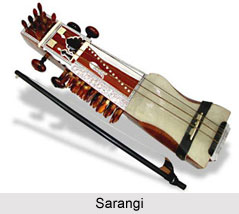 Musical Instruments of Haryana
Musical Instruments of Haryana
Musical instruments of Haryana also play important roles in enhancing the essence of regional music. Ektara is a one stringed instrument played with the help of fingers. Dotara is similar to Ektara having two strings. Sarangi is played with a bow. It is highly popular among the folk music of Haryana. Another significant musical instrument of the state is Been. It is mainly used by snake charmers and is made of two bamboo pipes. Bansuri is a wind instrument made of a hollow bamboo stick. In mythology, Bansuri has been depicted as the favourite musical instrument of Lord Krishna. Shehnai is another common instrument widely used in marriage ceremonies. Shankha is on of the oldest wind instrument of the country and is considered as one of the attributes of Lord Vishnu. It is believed to be very sacred and is used in temples and religious ceremonies.
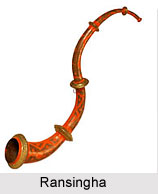 Musical Instruments of Uttarakhand
Musical Instruments of Uttarakhand
The state of Uttarakhand also enlists a number of musical instruments. Dhol is a percussion instrument, a double headed drum. It accompanies regional music of the state. Ransingha is another instrument which is actually the primitive trumpet. Two metal curves are joined together in an `S` shape in Ransingha. Dholak is also a double headed drum played with hands. It comes in varying sizes and accompanies folk music of Uttarakhand. Bhankora is a long horn composed of copper and is generally played in religious ceremonies. Other musical instruments of the state are damoun, turri, daur, thali, masakbhaja, harmonium and tabla.
Musical Instruments of Himachal Pradesh
Music is an important aspect of the culture of Himachal Pradesh and a variety of instruments have also evolved in the state to accompany the regional music. Wind instruments of the state include algoza, shehnai, peepni, karnal, bishudi, and ranasingha. Drum based percussion instruments of the state are dammama, gajju, damanght, dhaunsa, doru, dholku, nagara, tamaka, hudak etc. Non drum percussion instruments include ghanta, chimta, ghariyal, manjira, jhanjh, thali, ghungru etc. A number of string instruments are also prevalent in the state are gramyang, sarangi, riwana, ruman, jumang, ektara and kindari davatra.
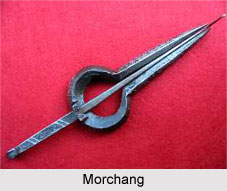 Musical Instruments of Jammu and Kashmir
Musical Instruments of Jammu and Kashmir
Musical instruments of Jammu and Kashmir have also acquired a distinct place in the Indian music. Damman is a famous instrument composed of two kettle drums. It produces a deep and heavy sound. Skaling is a double flute played jointly. Santoor is a 100 stringed instrument and is popularly known as the "Vena of Kashmir". Another stringed instrument is Saranda which is played with a bow. Noot is another instrument which is an earthen pitcher. It produces rhythmic beats which greatly accompanies the folk songs of Kashmir valley. Sitar, Tumbknari, Ransingha, Dahara, Saz-e-Kashmir, King, Rabab, Daph, Dingjam, Gling-Liu, Dukkar, Gharah and many other instruments are widely used in Jammu and Kashmir.
Musical Instruments of Rajasthan
Kamayacha is a famous musical instrument of Rajasthan which is mostly played along with professional singers of Mangniars community. Rawanhatta is made of half coconut shell resonator which is covered by membrane. A bow is used to play the instrument. Bankia is a bass instrument similar to a trumpet. It enhances the vigour of a variety of folk music of the state. Morchang is a wrought iron musical instrument. A variety of musical notes and beautiful rhythmic patterns are produced with Morchang. Shehnai is also common in Rajasthan played especially during weddings. It is double reed instruments accompanied by nagara.
Different states of northern India have developed their unique musical instruments. Several categories of instruments like wind instrument, stringed instrument, percussion instrument etc have come into existence which accompanies various regional, folk, ritualistic and devotional songs. Many ancient instruments are still in use with certain modifications. Evolution of Musical Instruments of Northern India had witnessed varying cultural influences through years. They have also immensely enriched the cultural heritage of India.
Musical Instruments of Western India
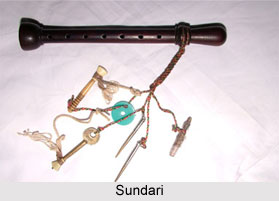 Musical Instruments of Western India form an indispensable part of Indian music. Since time immemorial, they have played a vital role in augmenting the charm of different genres of music. Over years, different states of western India have developed a variety of musical instruments belonging to different categories like stringed instruments, percussion instruments, woodwind instruments etc. Earlier these instruments were manufacture with wood, animal skin, bones and other natural substances but later combination of synthetic materials was also introduced to improve their sound and durability.
Musical Instruments of Western India form an indispensable part of Indian music. Since time immemorial, they have played a vital role in augmenting the charm of different genres of music. Over years, different states of western India have developed a variety of musical instruments belonging to different categories like stringed instruments, percussion instruments, woodwind instruments etc. Earlier these instruments were manufacture with wood, animal skin, bones and other natural substances but later combination of synthetic materials was also introduced to improve their sound and durability.
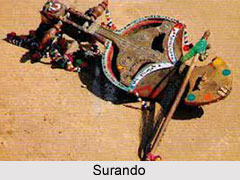 Musical Instruments of Gujarat
Musical Instruments of Gujarat
Gujarat houses a variety of music instruments that enrich the Indian music. Sundari is a double reed wind instrument. It is mostly played by the Langa community of Kutch. Bhorrindo is an ancient instrument that accompanies the folk music of the state. It resembles a clay ball having few holes of different sizes to produce sounds. Surando is another stringed instrument of Kutch region of Gujarat. Morchang is popular among the shepherd community and is mostly played along with the folk music of Kutch. Kani is another reed instrument, common in the state. Jodia Pawa is a pair of flutes having same length. It is also popular among the shepherds of the dessert area. Another musical instrument of the state is Ghado or Ghaghar which is a baked earthen jar. It is played along with Surando.
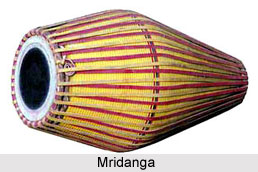 Musical Instruments of Goa
Musical Instruments of Goa
A number of musical instruments have evolved in Goa which accompanies the traditional music of the state. Ghumot is a percussion instrument which is basically an earthen vessel with leather mounted on one open end. It is an integral part of folk and religious music of Goa. Tambura is a stringed instrument which produces beautiful melodies. It comes in different sizes and is played with folk as well as classical music. Mridanga is another percussion design. It is a two headed drum made of terracotta. It is a great accompaniment in devotional music. Tabla comprises of a pair of hand drums of different sizes and produces different sounds. Extensive use of hands and palms is required in playing of Tabla. Apart from this other instruments of Goa include dhol, kasale, madlem, surt, shehnai, nagado, tasso, mandolin, violin and piano.
Many of the musical instruments are exclusively played with different genres of music like devotional, religious, folk or contemporary. Although Musical Instruments of Western India have undergone numerous transformations, a number of ancient instruments are still used with certain forms of Indian music. Be it classical or contemporary, these instruments greatly enrich the aura of the songs. They also form an essential part of the cultural heritage of India.
Musical Instruments of Southern India
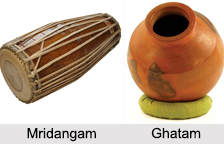 Musical Instruments of Southern India can be best seen as cousins of their North Indian counterpart. South Indian or Carnatic musical instruments are more about percussion instruments than melody. Some of the popular South Indian instruments are:
Musical Instruments of Southern India can be best seen as cousins of their North Indian counterpart. South Indian or Carnatic musical instruments are more about percussion instruments than melody. Some of the popular South Indian instruments are:
Morsing - Morsing is a Carnatic percussion instrument held in the left hand, shaped like prongs with an additional metal stick running through the length of the instrument.
Mridangam - The primary drum used to accompany classical performances is the Mridangam. The drum is made of heavy wood and the arrangement of the entire drum is very similar to the Pakhawaj.
Ghatam - Ghatam, the second percussive instrument is pretty much an earthen clay pot. The range of sounds is incredible and is used in classical music performances.
Kanjira - This is a South Indian version of the Tambourine. It has a snake-skin head and jingles. It is also used in Carnatic music performances.
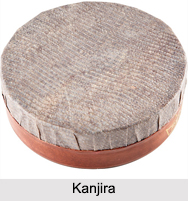 Shankha - Shankha is a conch shell primarily used in religious music of Hinduism and Buddhism. The shell is got from the shell of a large predatory sea snail that lives in the Indian Ocean.
Shankha - Shankha is a conch shell primarily used in religious music of Hinduism and Buddhism. The shell is got from the shell of a large predatory sea snail that lives in the Indian Ocean.
Thavil - Thavil is very similar to the North Indian concept of Dholak and Nagara. This drum is used to accompany performances of the Nadaswaram. It is played with thimbles, tacks and sticks.
Saraswati Veena -Saraswati Veena is the instrument of the Goddess of arts, Saraswati Devi. This is the South Indian version of the Sitar. There are 4 main strings, 3 drone strings and no sympathetic strings.
Violin - Violin has a very important role in Carnatic music. Its function is the same as the Sarangi or Harmonium. They both accompany the vocalist.
Tambura - Tambura is very similar to the Hindustani Tanpura. The sound box is made of jack wood and bridge is made of bronze instead of bone. It also serves as a drone in the background of Carnatic music.
Nadaswaram - This is the South Indian version of the Shehnai. It is a little bit bigger and has only 2 reeds compared to the Shehnai`s 4 reeds. This is also used as a snake charmer.
Udukkai - Udukkai is an hourglass shaped, membranous drum which is used in devotional and folk music throughout India. It is played with the hand and the pitch may be altered by tightening the lacing in the middle.
Venu - Venu is a bigger version of the Bansuri.
Thalam - Thalam is a finely tuned brass cymbals which serve as a generic supplement to accompany rhythms in Carnatic classical music.
Musical Instruments of North-Eastern India
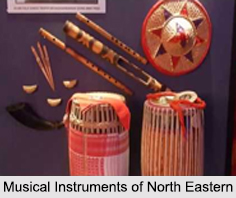 Musical Instruments of North-Eastern India are an integral part of the cultural heritage of the country. These instruments accompany the regional music of this region and add even more vigour to it. A variety of musical instruments are prevalent in North Eastern India which include different types of wind instruments, string instruments and percussion instruments. The music talents of the people of the North East can also be seen in their ingenuity in making unique and original musical instruments such as drums, tabla, flutes, mouth-organs, clarinets, harmoniums, guitars, trumpets, fiddles, the Jews-harps, leaf instruments, etc. These indigenous instruments are used in singing and dancing. A close study of these instruments reveals to us yet another aspect of the people" intimacy with Nature. It is Nature that inspires and also provides them with the required materials to create these instruments. Most of their instruments are created and designed by themselves.
Musical Instruments of North-Eastern India are an integral part of the cultural heritage of the country. These instruments accompany the regional music of this region and add even more vigour to it. A variety of musical instruments are prevalent in North Eastern India which include different types of wind instruments, string instruments and percussion instruments. The music talents of the people of the North East can also be seen in their ingenuity in making unique and original musical instruments such as drums, tabla, flutes, mouth-organs, clarinets, harmoniums, guitars, trumpets, fiddles, the Jews-harps, leaf instruments, etc. These indigenous instruments are used in singing and dancing. A close study of these instruments reveals to us yet another aspect of the people" intimacy with Nature. It is Nature that inspires and also provides them with the required materials to create these instruments. Most of their instruments are created and designed by themselves.
Musical Instruments of Assam
Dhol is a famous Assamese Instrument. It is a double headed barrel shaped drum. It is played with the aid of two wooden sticks composed of cane wood or bamboo and varies in size from region to region. Gogona is a reed instrument played mainly along with Bihu. It is constructed of a piece of wood or horn with bifurcation on one end. Another instrument of this state is Pepa made up of cane or bamboo, capped at one end with a horn. Taal is used along with traditional songs of Assam that makes a high pitched sound. Khol is a percussion instrument of Assam. It is a two sided drum made of terracotta. Dotara was initially adopted by Fakirs and Bauls as their traditional instrument. It is a string instrument having two to five strings. Besides these, other musical instruments of this state are Toka, Xutuli, Madol, Baanhi, Nagera, Ektara, Zuri tala etc.
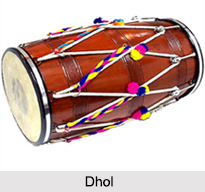 Musical Instruments of Tripura
Musical Instruments of Tripura
Music is an integral part of the culture of Tripura and a number of instruments have originated in this state. Among the ancient instruments of the state, a famous one is Sumui. It is made of bamboo and produces beautiful melodies. Sarinda is a string instrument mainly used by the tribal population. Chongpreng is another popular tribal instrument. It is a kind of chordophone lute composed of bamboo. Dangdoo is a combination of percussion and wind instrument. Kham is a double membrane drum used extensively in the regional music of the state. Kham is played by suspending it to the neck and tying to the waist. These are played with strings or hand. Lebang-Lebangti is one of the most special and unique instruments of Tripura. Uakhrap is also a traditional instrument. Its origin can be traced to ancient times. Rhythmic sounds are produced in this instrument with bamboo sticks.
Musical Instruments of Meghalaya
Musical instruments play a vital role in the art and culture of Meghalaya. Dama is a popular percussion instrument made of wood. It is a narrow and long drum producing strong rhythms. Kram is an instrument similar to Dama but a little larger one. According to tribal beliefs, the instrument is played only on special occasions. Another instrument is Nagra. It is generally played for assembling people at Nokma`s house for some entertainment of feast. Flutes are also a part of the regional music of Meghalaya. Gongmina is also known as Jew`s harp and is made up of a thin slit of bamboo. Cymbals are widely used by the regional people of Meghalaya which is played by hitting a pair of cymbals against each other. These are of two types namely Kakwa and Nenggilsi. Other regional musical instruments of this state are Rang, Trumpets, Tangmuri, Singdiengphong, Kynphong, Naila, Padiah etc.
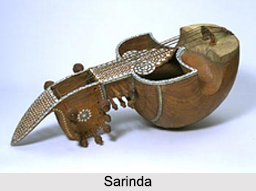 Musical Instruments of Mizoram
Musical Instruments of Mizoram
A number of musical instruments have also emerged in Mizoram. Khuang is a compulsory instrument for all the regional occasions of the state. It is a percussion instrument. Tawtawrawt is a kind of trumpet made of bamboo whereas Phenglawng is a flute which produces a variety of melodies. Hnahtum is another type of wind instrument which is made of leaves to produce different types of sounds. Tuium dar is a string instrument made of bamboo. It has three strings to create melodies. Tingtang is also known as Mizo guitar. It is also made of bamboo which is fixed on a gourd. Other instruments of this state include Lemlawi, Buhchangkuang, Rawchhem, Tumphit, Seki, Darbu, Darmang, Talhkhuang, etc.
Musical Instruments of Nagaland
Numerous musical instruments have also developed in Nagaland that accompany and enhance the beauty of regional music of the state. The instruments of Nagaland enlist Tati, Theku, Asem, Jemji, trumpets, cup violins, bamboo flutes and many more.
Musical Instruments of North-Eastern India are popular among the tribal as well as modern musicians. These instruments have been one of the key elements for the mesmerizing renditions of North East India. Several renowned artists have emerged over time, who have expertise in these instruments and have acquired huge fame throughout the country.




















